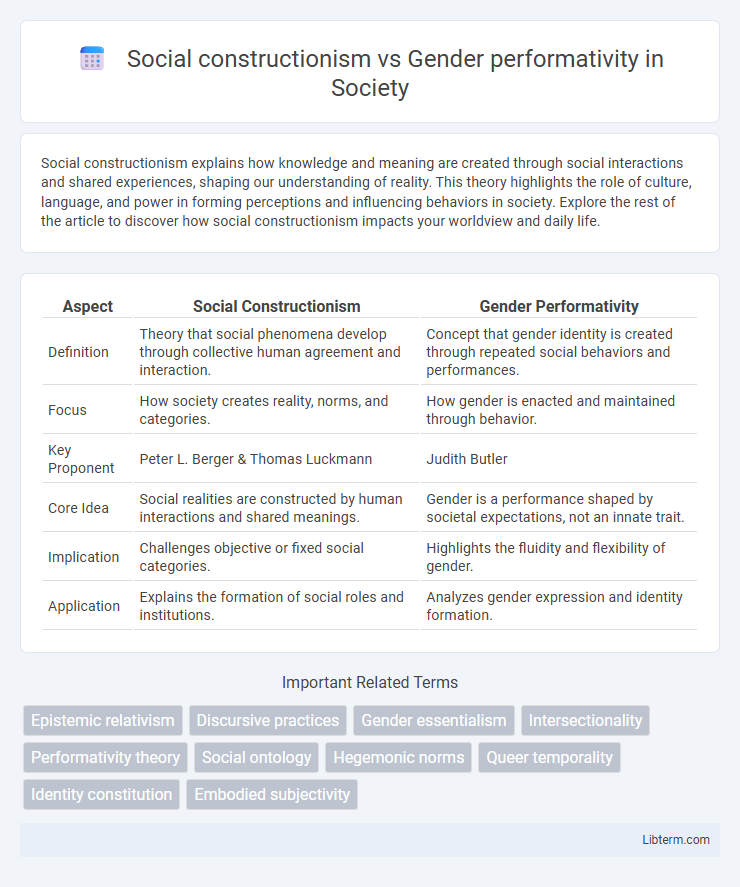Social constructionism explains how knowledge and meaning are created through social interactions and shared experiences, shaping our understanding of reality. This theory highlights the role of culture, language, and power in forming perceptions and influencing behaviors in society. Explore the rest of the article to discover how social constructionism impacts your worldview and daily life.
Table of Comparison
| Aspect | Social Constructionism | Gender Performativity |
|---|---|---|
| Definition | Theory that social phenomena develop through collective human agreement and interaction. | Concept that gender identity is created through repeated social behaviors and performances. |
| Focus | How society creates reality, norms, and categories. | How gender is enacted and maintained through behavior. |
| Key Proponent | Peter L. Berger & Thomas Luckmann | Judith Butler |
| Core Idea | Social realities are constructed by human interactions and shared meanings. | Gender is a performance shaped by societal expectations, not an innate trait. |
| Implication | Challenges objective or fixed social categories. | Highlights the fluidity and flexibility of gender. |
| Application | Explains the formation of social roles and institutions. | Analyzes gender expression and identity formation. |
Understanding Social Constructionism: Foundations and Key Concepts
Social constructionism posits that knowledge, identity, and reality are created through social interactions and shared beliefs rather than being inherently natural or fixed. Key concepts include the role of language, power dynamics, and cultural norms in shaping perceptions of gender, illustrating how meanings are negotiated within societies. Understanding these foundations highlights how gender identities emerge as collective social agreements rather than predetermined biological facts.
Defining Gender Performativity: Judith Butler’s Contribution
Judith Butler's concept of gender performativity challenges traditional views by arguing that gender is not an innate identity but a repeated set of behaviors and acts shaped by societal norms. This theory diverges from social constructionism by emphasizing that gender is actively produced and maintained through performance rather than merely constructed by social influence. Butler's work highlights how these repetitive acts create the illusion of a stable gender identity and reveals the fluidity and multiplicity inherent in gender expression.
Historical Context: Evolution of Gender Theories
Social constructionism emerged in the mid-20th century, emphasizing that gender identities are created through cultural and social interactions rather than biological determinants. Gender performativity, introduced by Judith Butler in the 1990s, built on this framework by arguing that gender is continuously produced and reinforced through repeated behaviors and performances. The historical evolution from social constructionism to gender performativity reflects a shift from viewing gender as a static social category to understanding it as a dynamic, performative process shaped by power structures.
Social Constructionism: How Society Shapes Gender Roles
Social constructionism asserts that gender roles are created and maintained through societal norms, institutions, and cultural practices rather than being innate or biologically determined. This theory highlights how language, media, education, and family structures contribute to the continuous shaping and reinforcement of gender identities and expectations. By understanding gender as a social construct, it becomes evident that these roles can evolve and change across different cultures and historical periods.
Gender Performativity: The Role of Repetition in Identity
Gender performativity emphasizes identity as a continuous act shaped through repetitive behaviors, gestures, and speech that align with societal gender norms. This repetition solidifies and enacts gender roles, making identity appear natural rather than constructed. Unlike social constructionism, which views gender as a product of social processes, gender performativity highlights the dynamic and performative nature of identity formation through ongoing, embodied repetition.
Comparing Frameworks: Points of Convergence and Divergence
Social constructionism and gender performativity both emphasize the socially created nature of gender, highlighting how cultural norms shape identities and behaviors. Social constructionism broadly addresses how knowledge and realities are constructed through social interactions, whereas gender performativity, as theorized by Judith Butler, specifically views gender as an ongoing performance enacted through repetitive acts. Divergence arises as social constructionism tends to analyze the external social structures influencing identity formation, while gender performativity focuses on individual agency in perpetuating or subverting gender norms through embodied practices.
Critiques and Limitations: Social Constructionism vs Gender Performativity
Social constructionism faces critiques for its broad generalizations about societal influence on identity, often overlooking individual agency and biological factors in gender development. Gender performativity is limited by its emphasis on repeated behaviors reinforcing gender, which can neglect the material realities and structural inequalities impacting gender identity. Both theories struggle with accounting for the complexity and intersectionality of gender experiences across diverse cultural and socio-economic contexts.
Impact on Feminism and Queer Theory
Social constructionism frames gender as a fluid and culturally contingent category, emphasizing how societal norms and power structures shape gender identities, significantly influencing feminist critiques of essentialism and promoting inclusivity within Queer Theory. Gender performativity, introduced by Judith Butler, centers on the repetitive enactment of gender roles, challenging fixed identities and enabling feminist and queer activists to deconstruct binary notions of gender. These theoretical frameworks collectively empower movements to contest normative gender constructs and advance intersectional approaches in contemporary gender politics.
Real-World Applications: Policy, Media, and Everyday Life
Social constructionism frames gender as a societal construct, influencing policies that promote inclusivity and anti-discrimination measures in education, workplace, and healthcare. Gender performativity, emphasizing enacted behaviors and repeated social acts, informs media representations and campaigns challenging traditional gender norms by highlighting fluidity and diversity. In everyday life, these theories shape personal identities and interpersonal interactions, encouraging practices that validate non-binary and transgender experiences across cultural contexts.
Future Directions in Gender Studies
Future directions in gender studies emphasize expanding the dialogue between social constructionism and gender performativity to deepen understanding of identity formation. Research increasingly integrates intersectionality with digital media's role in shaping gender expressions, advancing nuanced analyses of performative acts in virtual spaces. Interdisciplinary approaches combining neuroscience, sociology, and queer theory are also pivotal in exploring the fluidity and variability of gender beyond traditional binaries.
Social constructionism Infographic

 libterm.com
libterm.com